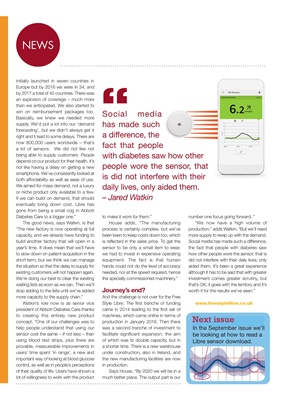
NEWS
Europe but by 2016 we were in 34, and by
2017 a total of 42 countries. There was an
explosion of coverage - much more than
we anticipated. We also started to win on
reimbursement packages too. Basically,
we knew we needed more supplies. We'd
put a lot into our 'demand forecasting', but
we didn't get it right and it lead to delays.
There are now 800,000 users worldwide -
that's a lot of sensors. We did not like not
being able to supply customers. People
depend on our product for their health, it's
not like having a delay on getting a new
smartphone. We've consistently looked
at both affordability as well as ease of
use. We aimed for mass demand, not a
luxury or niche product only available to
a few. If we can build on demand, that
should eventually bring down cost. As a
company Abbott has to look at what it
invests in. Libre is now important to the
organization. It's gone from being a small
cog to a bigger one."
The good news, says Watkin, is that
"The new factory is now operating at full
capacity, and we already have funding to
build another factory that will open in a
year's time. It does mean that we'll have
to slow down on patient acquisition in the
short term, but we think we can manage
the situation so that the delay to supply for
existing customers will not happen again.
We'll clear the existing waiting lists then
close them again until we've added more
capacity to the supply chain."